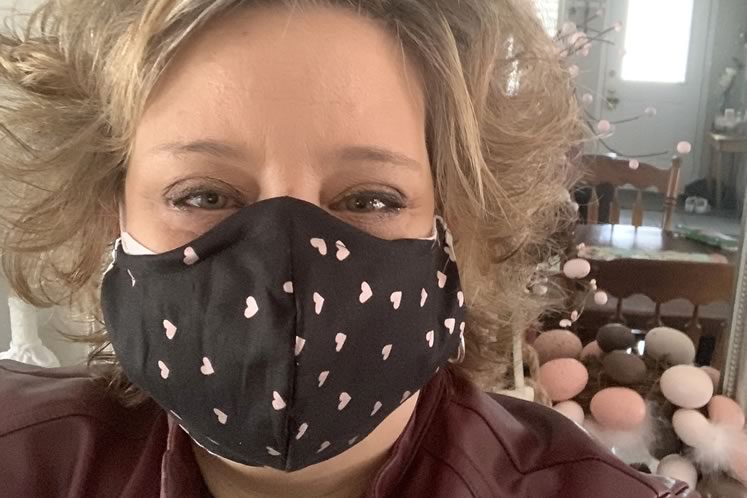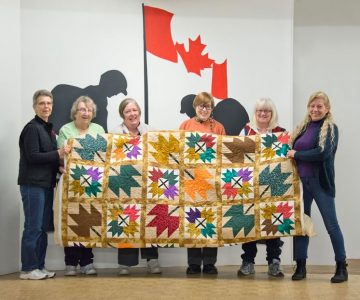Mask Makers, Assemble!
How local stitchers, engineers, manufacturers and teachers stepped up to create and donate face coverings and other apparel to beat back the virus.
When Sarah Aston first wore a futuristic clear face shield to a grocery store in early April, she felt a twinge of embarrassment. She was the only person wearing a covering of any kind.
“People were looking at me,” the Mono realtor recalls. By May, she says, “I felt naked without one.”
This was the whirlwind pace at which the trajectory of mask wearing changed in Headwaters. Aston was an early adopter because her husband, auto parts manufacturer Chad Blough, designed and created the Easyshield in his Orangeville auto parts workshop after his core business ground to a halt. He has now sold more than 10,000 shields.
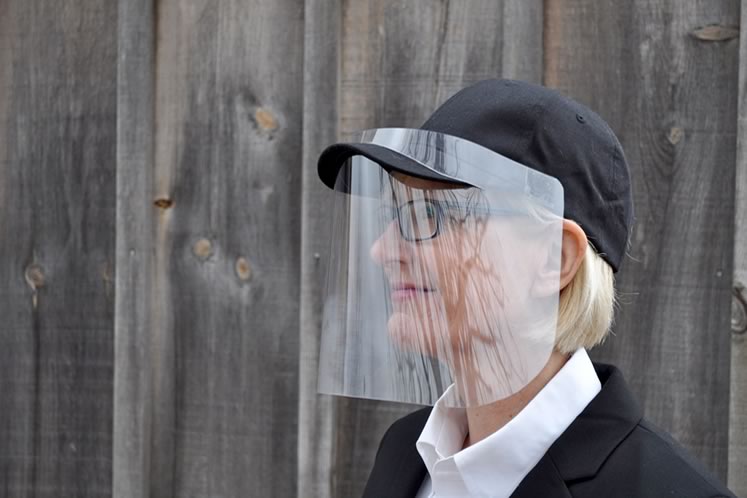
The Easyshield face shield created by Mono auto parts manufacturer Chad Blough. Photo courtesy Easyshield.
Blough’s quick pivot is just one of many instances of businesses and creators trying to keep the coronavirus out of our faces by quickly adapting to meet the demand for masks and shields. In doing so, they have become part of a larger narrative. Throughout this pandemic, masks of all kinds have emerged as a universal, if mutable, symbol of the global crisis. First, as we watched China and Italy, masks were an immediate signal telling us about the deadliness and contagion of Covid-19, the disease caused by the coronavirus. By the time Covid-19 hit Canada, masks were shorthand for the frightening scarcity of personal protective equipment for frontline health care workers. Now, the mask signals a wearer’s sense of anxiety or of civic duty, or a mix of the two.
Through each iteration of the disease, quiet heroes among us have been working to help move us to the next stage. For some, this involved donating money and protective supplies to local hospitals. For those who work with their hands, it meant mobilizing the workshop or sewing room. Sewer and quilter AJ Grace-Cavey of Cobwebs & Caviar, her quilting shop in Shelburne, has been sourcing fabric and materials for others, and sewing masks and other items herself. She’s not surprised at how the community has problem solved: “People who are creative jump to it.”
Filling the gap
In March, companies and individuals scrambled to help out even before Headwaters Health Care Centre put out a call for donations. The hospital’s Sharon Hendry was asked to step away from her daily role as quality and patient experience specialist to co-ordinate the donations already flowing in, including medical-grade personal protective equipment such as N95 masks (so named because they filter out 95 per cent of airborne particles), as well as face shields and pleated surgical masks. She says the PPE donations came so fast that the hospital hasn’t been able to keep up with the tally.
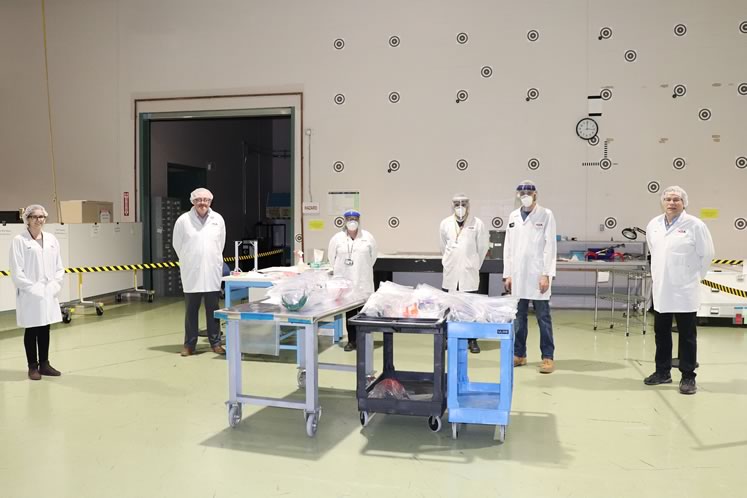
Employees at Brampton robotics company MDA Corporation, many of whom live in Caledon and Dufferin, designed and produced face shields to donate to Headwaters Health Care Centre and others. Pictured from left are Emily Keates, Bill Reil, Michelle Skorupa, Lee Paul, Sheldon Cramp and Bruce Walker. Photo by Rathan Balasingam.
Bruce Walker of Mono guided the donation to Headwaters of 250 face shields made by his employer, Brampton-based robotics company MDA Corporation. Felix and Marcel Mueller, owners of Orangeville’s Triple M Tool & Mfg., donated about 300 face shields they had retooled their equipment to produce. Jim Carson of Blackstock Ford in Orangeville gave 200 face shields, and Shelburne auto parts manufacturer KTH supplied 7,000 surgical masks. Caledon’s Margot and Joe Crump sourced 185 N95 masks and nearly 25,000 surgical masks via their Brampton dog food company, Crumps’ Naturals. And the lists goes on.
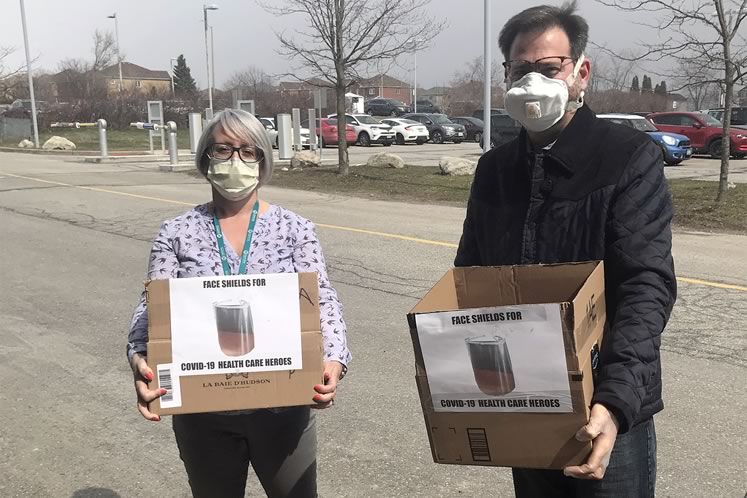
Felix Mueller of Triple M Tool & Mfg. (right) in Orangeville donated the face shields he and his brother Marcel made for workers at Headwaters Health Care Centre. The hospital’s Sharon Hendry co-ordinated the donation effort. Photo courtesy Headwaters Health Care Centre.
Hendry says she sends weekly inventories to the Ministry of Health. In mid-May, a single week’s tally included more than 29,000 surgical masks, 134 N95 masks and 3,856 face shields. Enough, says Hendry, that the hospital has been able to reallocate many of these supplies to other local organizations in need.
As part of Peel Region’s mask drive, residents were asked to drop off supplies at three locations in the region, including the Caledon fire department headquarters in Caledon East. Bolton chiropractor Ryan French tapped into a supply chain very close to home – his father and uncle’s alterations chain, Stitch It, which has pivoted to making surgical masks. French bought 1,000 to donate. “I’m so proud of what they’re doing. Everyone is doing what they can,” he says.
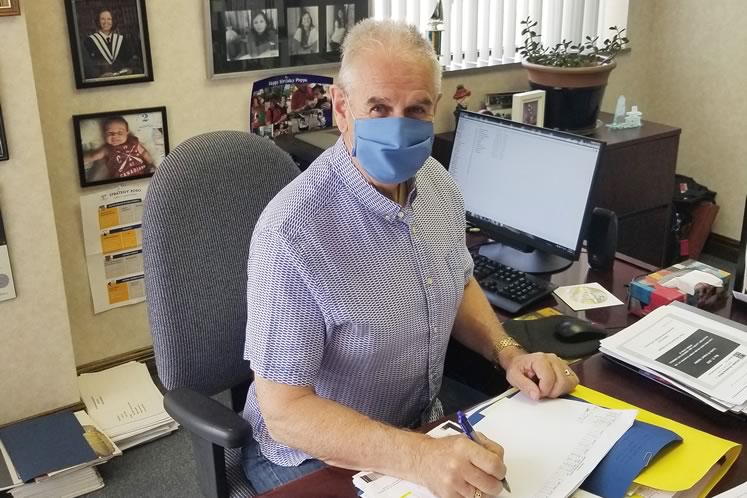
CEO Alain Baird of Stitch It wears a blue surgical mask his company has started making. His nephew, Bolton chiropractor Ryan French, bought and donated 1,000 of these masks to the Region of Peel. Photo courtesy Stitch It.
That’s also true of a group of Upper Grand District School Board educators, including Len Guchardi, a teacher at Centre Dufferin District High School. In mid-March they redeployed their schools’ 3D printers, taking them home to print blue plant-based polymer frames. They’ve since donated more than 9,000 to hospitals and other facilities in Dufferin, Erin, Guelph and Waterloo. The plastic shields inserted in the frames are made from sheets used as overhead transparencies.
At the peak of the outbreak, Guchardi was printing 30 frames a day, often waking up at night to start a new batch. The group wanted to supplement hospital stocks until medical-grade supply chains were running smoothly. When that started to happen, the group shifted their donations to other organizations such as nursing homes. Locally Guchardi arranged donations of 150 shields to Headwaters Health Care Centre, 100 to Dufferin Oaks, 100 to Shelburne Residence and 50 to the Shelburne police department. “We are just doing our part. That’s what the community does,” he says.
Like Hendry, Steven Dickson was seconded from his existing role – in Peel’s housing and legal departments – to become the logistics lead in Peel’s PPE drive. He says these citizen-led efforts were up and running so quickly that he had little time to set any expectations or goals. So far, donations in Peel have reached nearly 41,000 masks of all kinds, among other items. “I’ve been reassured to know that in every area, everyone has stepped up. If you don’t need your PPE, you share. If you need, you get.”
The generosity grows
As the need for masks and shields for frontline workers was being met, the makers’ momentum began to turn to the needs of the broader community. Local quilters and sewers couldn’t create medical-grade surgical masks for use in hospitals, but they could sew sturdy copies, with nose pinches and pockets for filters.
The Dufferin Piecemakers Guild has been the driving force behind many of these efforts. Guild members have been active in the community for 25 years, donating quilts and other items to local fire victims and various community groups, but the pandemic has been an all-hands-on-deck affair for dozens of guild members and community volunteers. “It’s part of our DNA as a quilting guild,” says co-president Oksana Slipenkyj. “It’s a historic time. Sewers and quilters knew they could do something to help.”
The group feeds three production streams. The first is masks for community members and local businesses who are asked to donate $5 a mask. Funds raised through this stream are earmarked for donation to local nonprofit groups and to support community outreach programs. By early June the guild had raised $3,000 and donated proceeds to Dufferin Food Share, Shepherd’s Cupboard Food Bank, Choices Youth Shelter and Family Transition Place.
The second stream includes scrub caps, headbands, ear savers (fabric bands that hold the mask elastics together behind the head) and scrub bags, which were given to workers at Headwaters Heath Care Centre, as well as to staff at long-term care and retirement homes. And to mark Nursing Week, the guild donated to the hospital about 300 packages that included scrub caps and headbands labelled “We love nurses.”
Isolation gowns, the third stream, were donated to groups and agencies such as Community Living Dufferin, Dufferin Oaks and Cedar Heights Residential Living.
The guild, too, has lost track of numbers. Member and well-known local quilter Judy MacLeod figures they’ve created more than 800 masks, 900 scrub caps and 300 gowns, as well as 500 headbands and 170 ear savers. All the fabric and nearly all additional materials have been donated, including the roughly 3,000 buttons used on some items. One woman donated a large antique cookie tin full of them, telling Judy, “This is three generations of buttons in here.”
Cobwebs & Caviar’s AJ Grace-Cavey was a major donor of materials and sewing time, even as she worried about the future of her small retail business. She is also privately making masks for sale for $13. “Thank you, eight seasons of Modern Family and my incredible family,” she says. “My sewing room hasn’t seen this much action in years.”
Of women like Slipenkyj, MacLeod and their network, Grace-Cavey says, “They are the strongest, sweetest, most altruistic people I know. So many said, ‘What do I have? What can I pull out? Making something is more important than my needs.’ I’m honoured to be part of this group.”
Fellow sewer Janet Manschitz, also of Shelburne, has been sewing fabric masks ever since Canada’s chief public health officer Teresa Tam recommended their use when social distancing isn’t possible. Manschitz posted a callout on a local Facebook group and her cellphone started pinging immediately. “You couldn’t buy anything at that point,” she says. At first, fabric was limited to what she had on hand. “It was, ‘You get what you get,’” she says. “I wasn’t trying to be rude, but I had to say, ‘No, I don’t have a black polka dot, sorry.’”
Manschitz lost count at 500. At first, she gave them away for free, but like most sewers she started asking for a donation – $10 each in her case – to cover her costs and make sure she could keep up with demand. To pay it forward, some buyers bulk up their donation – one woman paid $100 for two masks. Manschitz also raises money for other local charities by holding online auctions. It has been rewarding, she says, but she is happy to be slowing down. “I’d get up at 8 a.m. and be in my sewing room until 2 p.m. I did this for three weeks solid. It was exhausting.”
What now?
By late May, many mask and shield makers had filled acute needs in our communities and, like Manschitz, were considering taking well-deserved breaks. For those of us still interested in stocking up on what looks as if it will become a wardrobe staple, other options abound. Chad Blough of Easyshield is producing three varieties: one that fits a baseball cap brim, one for construction caps and one for shorter-brimmed bump caps. They come in packages of six for $20. They’re worn by everyone from transit workers to staff at manufacturers, including cheese-maker Saputo.
And finding a fashion-statement black polka-dot version – or really, just about any print you fancy – is no longer a stretch. Many small businesses, including Shelburne’s Prim Pickins, Grand Valley’s CT Designs, and Orangeville’s Say It with Stacey and Go Yoga, have added masks to their Etsy and online shopping sites. RaDeana Montgomery of Orangeville started a new mask business (see her story among the “Pandemic Journals”), and Caledon artist Lucille Weber is giving away pay-it-forward masks and sharing updates on the Village of Inglewood Association Facebook page.
At the same time, the symbolism attached to the mask continues to mutate. Is it a sign of respect for your fellow citizens, a statement of solidarity with frontline workers? Or is it an infringement on your personal freedom, as one line of debate goes, particularly in United States? During the Black Lives Matter protests in early June, masks did extra duty as canvases for powerful anti-racism slogans none of us will soon forget.
From the Lone Ranger to Batman, the Phantom of the Opera to Darth Vader, religious apparel to masquerade accessories, and the holdup bandits of old-time Westerns to contemporary terrorists, face coverings have always been heavily freighted with social and cultural symbolism: heroic, fun, frightening, controversial. Nevertheless, in this current crisis, polls suggest most of us embrace masks, not as laden symbols but as the practical public health tools they are.
In May, a meta-analysis funded by the World Health Organization and published in The Lancet found that N95 and other similar respirator masks do indeed dramatically reduce the risk of infection from the coronavirus and should remain the gold standard for workers at hospitals and other high-risk locations. Surgical paper masks, too, substantially reduce the risk, though less dramatically than N95s, and homemade cloth masks are considered an effective choice for the general public.
So effective, they’re starting to be mandated here in Headwaters. As retail stores and other businesses serving the public began to reopen in Dufferin in mid-June, Nicole Mercer, medical officer of health for Wellington Dufferin Guelph Public Health, issued an order requiring them to refuse entry to customers or employees not wearing a mask – or be liable to fines.
Need another reason to mask up? What if wearing one is a way to thank all the shield and mask makers who have been burning the midnight oil? Despite her fatigue, Manschitz, for one, is still taking orders. As she puts it, “My goal is to get a mask on everybody.”
Related Stories
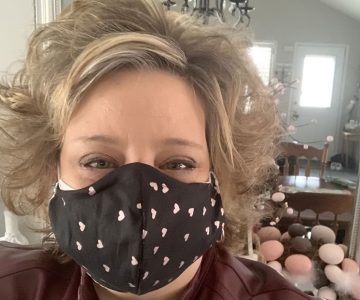
“I am now on my third sewing machine”
Jun 23, 2020 | | Pandemic JournalsHow an amateur stitcher found purpose in making masks.
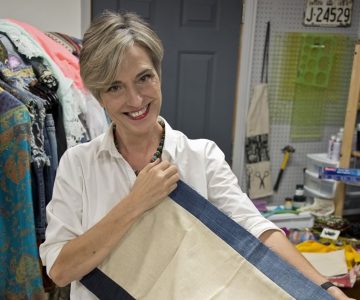
Meet the Maker: Heather Chapplain
Sep 18, 2018 | | Made in the HillsAs this Alton textile artist leans into her quirky, one-of-a-kind designs, Hollywood comes calling.
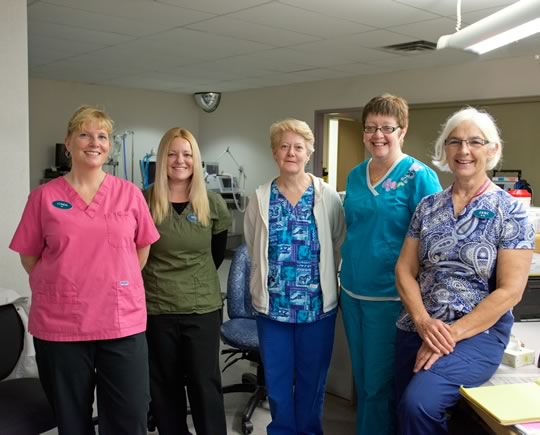
Intensive Care Nurses at Headwaters Health Care Centre
Nov 19, 2013 | | Local HeroesLocal Heroes: Lynda Lidwill, Wendy McDonald, Roseanne Rutledge, Judy Lomas and Jane Howard – ICU nurses.
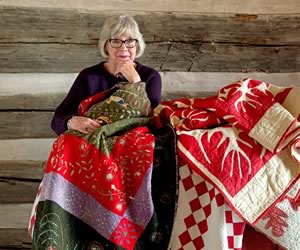
Stitches in History
Nov 19, 2013 | | Back IssuesThe Quilts of Dufferin County beautifully records the art and lives of women.
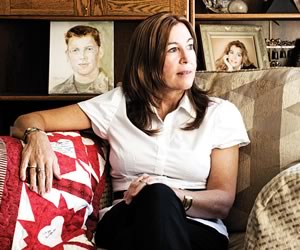
No Greater Sacrifice: Valerie McGrady & Cpl Matthew McCully
Nov 18, 2008 | | Local Heroes“It hurts every time I hear that another soldier is dead. I know the pain their families are going to experience.”





